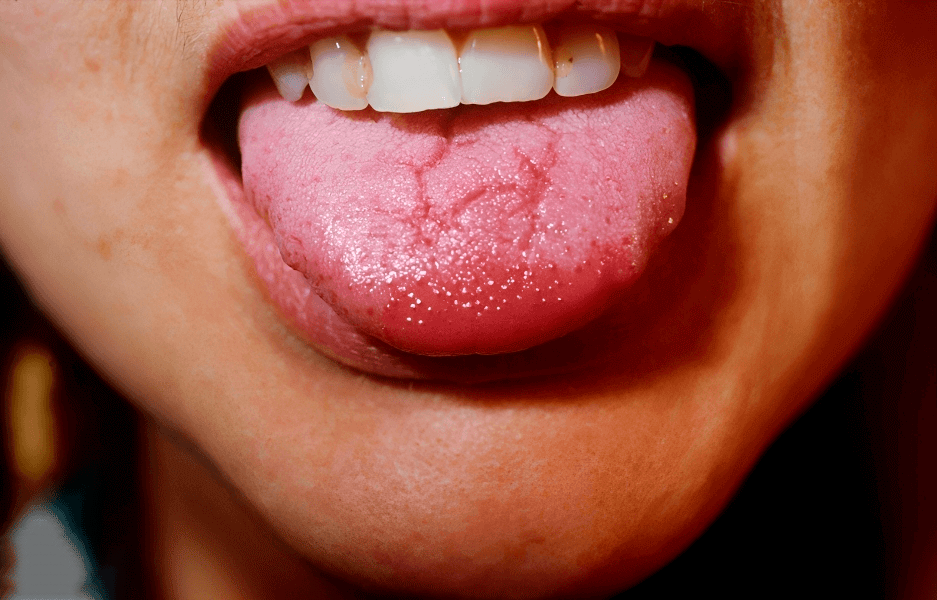The tongue, an essential component of our oral health, is a complex organ with a surface covered by a delicate mucous membrane. This intricate structure includes tiny papillae on its posterior surface, which typically go unnoticed. However, these papillae can occasionally cause discomfort, leading to the development of bumps on the back of the tongue. In this comprehensive article, we’ll delve deeply into the various causes of these tongue bumps and explore a wide array of potential treatments, all with the ultimate aim of enhancing your oral health and overall well-being.
Bumps on the Back of the Tongue: A Closer Look at Causes

Bumps on the tongue can have diverse origins, ranging from minor irritations to more concerning underlying conditions. Some common factors contributing to these bumps encompass:
1. Hot or Cold Foods:
Exposure to extreme temperatures, whether it’s scalding hot soup or freezing ice cream, can result in transient lingual papillitis, commonly referred to as “lie bumps.” These small, painful bumps often resolve on their own, but their sudden appearance can be alarming.
2. Irritating Foods:
While acidic or spicy foods are undeniably delicious, they can sometimes trigger discomfort, leading to the development of tongue bumps. Avoiding such foods can be a proactive step in preventing their occurrence and the subsequent discomfort they bring.
3. Tongue Injuries:
Accidental biting, abrasive dental appliances, or other traumas can result in localized irritation, leading to the development of bumps on the tongue’s surface. These traumas can be quite common and, thankfully, tend to resolve with time and proper care.
4. Acid Reflux:
Gastroesophageal reflux disease (GERD) can cause stomach acid to flow back into the mouth, potentially leading to tongue irritation and the development of bumps. Managing GERD can help alleviate this issue, emphasizing the importance of addressing underlying medical conditions for oral health.
5. Stress:
Emotional stress can manifest in various ways, and one of these manifestations can be the appearance of bumps on the tongue. Stress management techniques may help prevent or alleviate these discomforts, highlighting the intricate connection between mental well-being and oral health.
Potential Underlying Conditions: Deeper Implications

While many tongue bumps are benign and transient, some may be linked to underlying conditions that necessitate closer attention. These conditions include:
1. Canker Sores:
Painful sores that can develop on the tongue or other oral surfaces, often associated with stress or injury. While canker sores can be uncomfortable, they are generally benign and can be managed with appropriate home care.
2. Eruptive Lingual Papillitis:
This viral infection can cause enlarged and red bumps on the tongue, with children being particularly susceptible. Fortunately, it’s a self-limiting condition and tends to resolve without medical intervention, underscoring the importance of understanding its nature.
3. Oral Cancer:
Persistent bumps on the side of the tongue, particularly if they are hard and painless, could be indicative of oral cancer. Such cases warrant immediate medical evaluation, as early detection and treatment are critical for managing this serious condition. This highlights the importance of regular oral health check-ups.
4. Other Medical Conditions:
Certain infections like syphilis, human papillomavirus (HPV), or conditions such as glossitis, lymphoepithelial cysts, and traumatic fibroma can also lead to the development of tongue bumps. These cases require medical attention and treatment tailored to the underlying condition, emphasizing the need for a comprehensive approach to oral health care.
Diagnosis and Treatment: Navigating the Path to Relief

Identifying the cause of tongue bumps often involves a visual examination and symptom assessment by a healthcare professional. Once the cause is determined, appropriate treatment can be prescribed:
1. Medications:
In some cases, antibiotics or topical oral gels may be recommended to address underlying infections and provide relief from discomfort. This approach is commonly used for infections like bacterial or viral conditions, underlining the role of medication in oral health.
2. Home Care:
Home remedies can also aid in symptom relief, regardless of the underlying cause. Saltwater or baking soda gargles, non-alcoholic mouthwash, and lifestyle adjustments can contribute to a more comfortable oral environment. These remedies are particularly useful for managing benign conditions like canker sores, highlighting the effectiveness of simple, at-home solutions.
3. Surgery:
In cases where recurring bumps are suspected of being cancerous or are causing significant discomfort, surgical intervention may be necessary to remove the affected tissue. Surgery is typically the primary course of action for oral cancer and other serious conditions, emphasizing the role of medical procedures in ensuring long-term oral health.
Prevention Is the Best Cure: Proactive Measures

Preventing tongue bumps is often more effective than treating them. Key preventive measures include:
1. Good Oral Hygiene:
Regular brushing, flossing, and tongue cleaning can help prevent infections and painful bumps. Maintaining good oral hygiene is essential for overall oral health, and these basic practices play a fundamental role in keeping your mouth healthy.
2. Staying Hydrated:
Drinking an adequate amount of water can promote oral health and minimize the risk of tongue bumps. Proper hydration aids in the natural healing and maintenance of oral tissues, emphasizing the importance of hydration in overall well-being.
3. Avoiding Irritating Foods:
Steer clear of acidic, spicy, and irritating foods that can trigger discomfort. A diet that is gentle on your oral tissues can help prevent the development of tongue bumps, highlighting the significance of dietary choices in oral health.
4. Abstaining from Tobacco:
Tobacco products can contribute to tongue issues, so avoiding them is beneficial for your oral health. Smoking and using tobacco can lead to various oral health problems, including bumps on
the tongue. This underlines the importance of making lifestyle choices that support oral health and well-being.
A Bump-Free Tongue for Optimal Oral Health

In conclusion, bumps on the back of the tongue can be discomforting, but with the right understanding and care, they are often manageable and treatable. Recognizing the potential causes, seeking timely medical attention when needed, and adopting good oral hygiene practices are pivotal steps in ensuring a healthy and bump-free tongue. Regular dental check-ups further contribute to overall oral health and well-being, reinforcing the importance of consistent care and vigilance in oral health management. Your oral health is a vital component of your overall well-being, and taking steps to maintain it is an investment in your long-term health and quality of life.



Leave a Reply